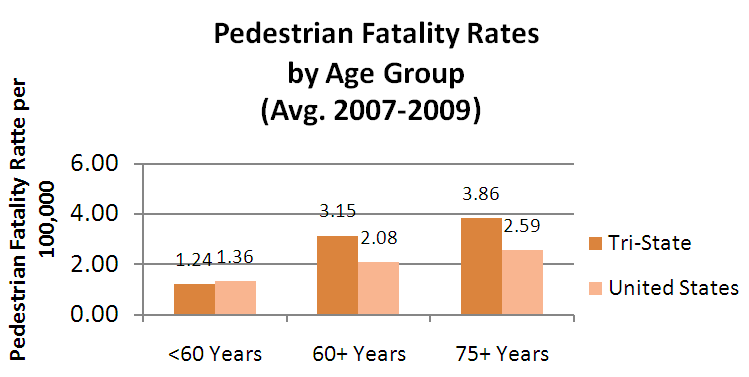Tri-State’s newest report, Older Pedestrians at Risk, finds that older pedestrians continue to be far more likely to be killed while walking than their younger neighbors. In addition, the tri-state region continues to have a much higher older pedestrian fatality rate than the rest of the country.
Between 2007 and 2009, 433 pedestrians aged 60 years and older were killed on the tri-state region’s roads. Though comprising only 18.1 percent of the region’s population, people over 60 accounted for more than 35 percent of the total pedestrian fatalities during the three-year period. Those aged 75 years and older represent just 6.4 percent of the region’s population, but more than 15 percent of pedestrian deaths.

The region’s older pedestrians are more than 2.5 times more likely to be killed in a crash than their younger neighbors. TSTC’s previous report, which looked at pedestrian fatalities from 2006-2008, similarly found that older pedestrians were at greater risk.
Nearly two-thirds of older pedestrian deaths took place on wide, high-speed thoroughfares which traffic engineers call arterials.
Tri-State and other advocates called on state governments to do more for pedestrian safety:
- In New York, Tri-State, AARP and Transportation Alternatives called on Albany officials to pass the currently pending complete streets legislation (S.5411) to make roads safer for all.
- In New Jersey, Tri-State and AARP said the state should track implementation of NJDOT’s 2009 Complete Streets policy, restore funding for the Safe Streets to Transit pedestrian safety program, and fix its most dangerous roads for walking including Black Horse Pike (US-322) and White Horse Pike (US-30) in Atlantic County, and Route 130 (Burlington Pike) in Burlington County.
- In Connecticut, Tri-State and AARP called on the state to create and fund Safe Routes to Seniors and Safe Routes to Transit programs, and designate a greater portion of federal transportation funds to pedestrian safety.
The Campaign’s analysis found that the most dangerous places in the tri-state region for older pedestrians included both urban and suburban counties. Ranked according to their older pedestrian fatality rate, the top ten counties were:
| Rank | County | Older (60+ yrs) Pedestrian Fatalities (2007-2009) |
Avg. Older Pedestrian Fatality Rate per 100,000* (2007-2009) | Avg. Total Pedestrian Rate per 100,000* (2007-2009) |
| 1 | Brooklyn, NY | 69 | 5.52 | 1.96 |
| 2 | Atlantic County, NJ | 8 | 5.07 | 3.57 |
| 3 | Manhattan, NY | 42 | 4.88 | 2.23 |
| 4 | Nassau County, NY | 39 | 4.67 | 2.14 |
| 5 | Camden County, NJ | 12 | 4.46 | 2.32 |
| 6 | Putnam County, NY | 2 | 3.98 | 1.68 |
| 7 | Essex County, NJ | 14 | 3.73 | 1.63 |
| 8 | Hudson County, NJ | 10 | 3.73 | 2.17 |
| 9 | Union County, NJ | 10 | 3.68 | 2.42 |
| 10 | Queens, NY | 44 | 3.54 | 1.57 |
*Fatality rates are calculated according to the population of the relevant age group (i.e., population aged 60 years and older, population under 60 years).
The full report and county-specific fact sheets can be found on TSTC’s website.

[…] all of the dangerous roads were arterials, a type of road that TSTC has found to be the most dangerous for pedestrians in the region as well. Arterial roads typically have two or more lanes in each […]
[…] roads. In its yearly analyses of the region’s most dangerous roads for pedestrians, TSTC has regularly found that the region’s arterial roads have higher shares of pedestrian fatalities. Improved […]